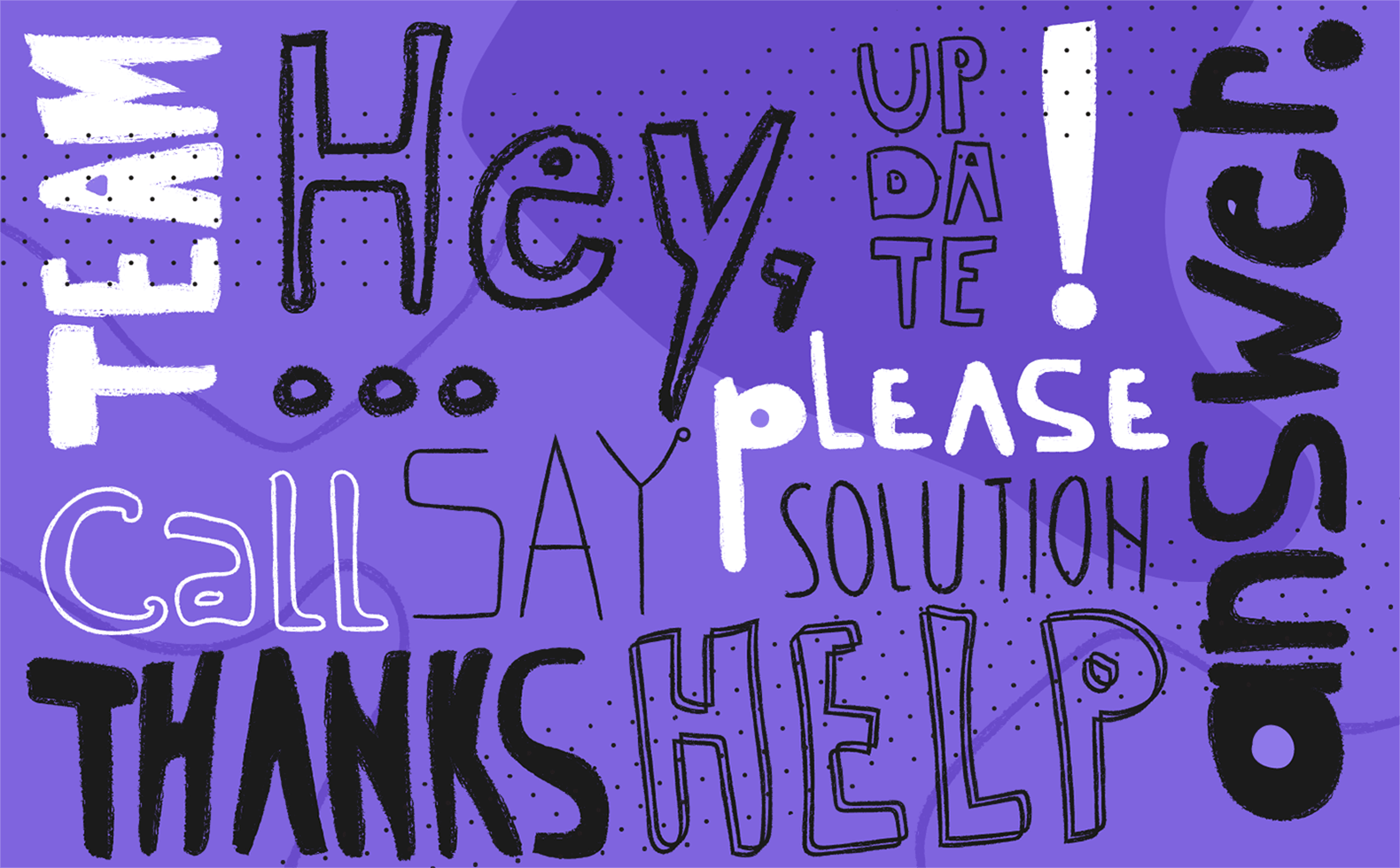I wish I could tell you, ‘Here are 10 customer service phrases to guarantee success.’ The truth is I can’t.
Customer service is about people. And—with people—magic formulas don’t exist. It’d be wonderful if all we needed was a cheatsheet of say and don’t say phrases. Unfortunately, things aren’t that simple.
(And you shouldn’t believe anyone who tells you they are.)
At the same time, however, there are universal truths about the way we process language.
Those truths are what this article is about.
The following one-liners have been crafted by thousands of real customer interactions here at Groove.
They’re not meant to be treated as holy incantations. But instead, best-practice dos and don’ts to quickly improve your customer service skills and—in turn—your customers’ overall experiences. The best part—they won’t make you sound like a robot. With those caveats out of the way…
Here are 10 customer service phrases to use and not use in your support conversations.
“I don’t know. But, I’ll find out for you.”
A recent survey asked respondents which common customer service phrases annoyed them most.
The winner?

Handing them off like hot potatoes is a great way to drive them away from you due to the sheer amount of (pointless and annoying) effort they have to put into trying to get help or information.
That’s especially true if you’re in a saturated market where customers have plenty of choices for who to do business with.
Good customer service isn’t always about knowing the right answer. Often, it’s about finding the right answer so that your customer doesn’t have to.
At Groove, we’ve taken these phrases and added them to a number of our canned replies. That means, they’re a standardized and automatic part of how we communicate with customers.
Note: If you’d like to see for yourself how Groove can help you simplify support and put customers first, sign up for a free trial here.
“I’d be frustrated too.”
There’s plenty of research on the importance of empathy in customer service. The topic is best summed up by Seth Godin in a one-line blog post:
The simplest customer service frustration question of all: “Why isn’t this as important to you as it is to me?”
We’ve all been there, whether it’s in a customer support setting or an argument with a friend or family member: it doesn’t feel good to talk to someone when you don’t think the person “gets” why you’re mad, upset or disappointed.
That’s why it’s critical to not just have and develop empathy but to convey it to your customer.
While mastering empathy might feel overwhelming at first, it becomes easier and easier as you work on it. (Just like any skill.)
When a customer is upset or angry—even if you didn’t do anything wrong—you can still be genuinely sorry about the way the customer feels. Let them know that.
“I’d be happy to help.”
Researchers Andrew Newberg and Mark Robert Waldman—in their book, Words Can Change Your Brain—found that using and hearing positive words physiologically alter how we see reality.
In a world where 95% of customers have taken action (e.g. abandoned a business or complained about it to others) because of a negative customer experience, a simple tactic like adding more positive power words to your support interactions can make a big difference.
When a customer emails you about an issue that they’re having…
Instead of responding with a bland “I’ll look into this for you,” tell them you’d “happily” help them find a solution.
The power of positive words is a psychological tip that’s easy to implement—both in the moment and over the long-term course of your relationship with them.
“I’ll send you an update by [specific day or time].”
If a customer sends Groove an email “checking in” on the status of their support request, we consider that a failure on our part.
In testing, we’ve found that customers who proactively reach out to us report satisfaction scores about 10% lower than customers who don’t inquire.
To prevent that, we do two things. First, we make sure that we keep the customer posted as often as possible (at least once per day). Second, we let the customer know exactly when they should expect to hear from us.
You can’t always promise a solution by a given time. What you can do is always promise an update.
Delivering on that promise doesn’t just keep the customer informed about the status of their request, but it’s another opportunity to build trust and let them know that you truly understand and care about the inconvenience they’re experiencing.
“I appreciate you letting us know. Thank you.”
According to a survey by Lee Resources International, for every angry customer who complains, there are 26 customers who don’t.
Each customer complaint could mean that dozens of other customers are having the same problem and not letting you know.
That means that resolving the problem for a single customer could make dozens of other customers happier at the same time.
That’s a huge opportunity.
In How to Win Friends & Influence People, one of Dale Carnegie’s fundamental techniques is being generous with appreciation: “In our interpersonal relations, we should never forget that all our associates are human beings and hunger for appreciation. It is the legal tender that all souls enjoy.”
Receiving gratitude doesn’t just change the way we think and feel; it changes the way we behave for the better.
Did they give you feedback? Say “thank you.” Did they report a bug? Say “thank you.” Did they complain about something? Say… well, you get the idea.
Make sure your customer knows how much you appreciate their email, no matter what the tone or contents of it are.
“Is there anything else I can help you with?”
Despite our best efforts and intentions, we don’t always get it right.
In fact, one survey suggests that although 94% of online retailers provide email customer service, 27% of email inquiries are answered incorrectly.
The fact is that there are times that our answers don’t end up being helpful. The problem is that research shows us that most people won’t speak up about problems.
So, if your reply isn’t helpful, some customers won’t proactively ask you to clarify or help any further.
That’s what makes this one of the most helpful customer service phrases you can use. By leaving the door open and inviting the customer to respond, you’ll give them a chance to let you know if anything remains unresolved.
What about the phrases you should never use?
Here’s our list of banned customer service phrases and alternatives for the next time you find them on the tip of your tongue:
“Nope.”
We all hate it when people are rude to us, but what we rarely think about is that sometimes, the way that we say things might come off as rude, even if we don’t mean it that way.
That’s why using the right tone in customer service is so, so important.
For example, a Software Advice survey tested various customer service scenarios on respondents, comparing a formal tone to a casual one.
While 65% of online customers — across all ages and genders — prefer a casual tone in customer service over a formal one, the numbers change significantly when the customer is being denied a request.
78% of respondents said that an overly casual tone (like using slang or emoticons) has a negative impact on their experience when the agent is denying a request.
By being too casual when you have to say no to a customer, you imply that you’re not taking their request seriously.
And that’s just rude.
What to say instead: “I’m sorry, that’s not something that we can do. However, what we can do is…” (Check out this post for more tips on saying “no” to your customers)
“Please calm down.”
Going back to the topic of empathy and why it matters in customer service, it’s good to remember that there’s hardly anything that feels more annoying than talking to someone who doesn’t understand that (or why) you’re annoyed.
Don’t be that person, especially in situations where you’re helping a customer.
Whether you’re arguing with a spouse or a friend, or trying to handle an upset customer, it’s never a good idea to tell them to calm down, because all it signals is that the problem isn’t as important to you as it is to them.
What to say instead: “I’m really sorry about that. It’s annoying to [have to deal with whatever they’re dealing with], and I’d be frustrated too.”
Caveat: this applies when the customer is not actually being abusive or mean. In those cases, all bets are off.
“It’s not our fault”
If your customer is upset, and you want to keep them a happy customer, then remember this: it doesn’t matter whose fault it was. It’s tempting to pass the buck, I know, but it truly. does. not. matter.
They’re your customer. They’re under your protection. And regardless of who is responsible for how they’re feeling, now your job is to make things right.
In this case, the first order of business is to apologize.
Even if you didn’t do whatever made them upset, you can still genuinely be apologetic for the way your customer feels (e.g., I’m always sorry that a customer feels upset).
Once you apologize, work on making things right.
What to say instead: “I’m really sorry for how frustrating this situation is, but I’m going to do everything I can to make things right.”
“Sorry, but it’s policy.”
Policies can be helpful. The right policies can empower your support team to build better relationships with your customers, and ultimately grow your business.
But policies are not excuses.
They are not walls to hide behind when you won’t give your customers what they want.
Of course, there are times when you can’t grant your customer’s wishes. But “it’s policy” is not an excuse.
Instead, have enough respect for your customer’s intelligence to explain why a policy is as it is.
Take a look at this brilliant example, Tweeted by Wistia’s Brendan Schwartz, of how a motel explains its policies to its customers:
A great example of how you can use policies for the benefit of your business, without hiding behind them and confusing and upsetting your customers.
What to say instead: “Sorry about the frustration, but here’s why this policy exists.”
The best customer service phrases: A final word of caution
In the same way that magical spells don’t exist, neither do you have to watch every word you say.
Customers appreciate the fact that you’re human, as long as you treat them with empathy and kindness.
In truth, how we say what we say matters far more than what we say.
Still, incorporating the positive and eliminating the negative can lead to easy wins. Who knows, it may just transform the way you talk, write, and even think about support.







